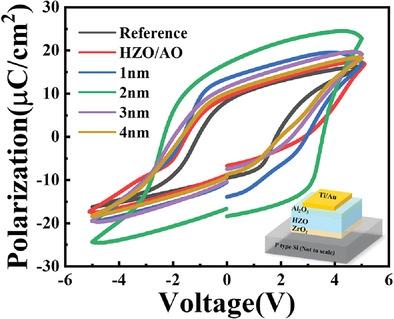当前位置:
X-MOL 学术
›
Adv. Electron. Mater.
›
论文详情
Our official English website, www.x-mol.net, welcomes your
feedback! (Note: you will need to create a separate account there.)
Structural Engineering of H0.5Z0.5O2-Based Ferroelectric Tunneling Junction for Fast-Speed and Low-Power Artificial Synapses
Advanced Electronic Materials ( IF 5.3 ) Pub Date : 2023-03-12 , DOI: 10.1002/aelm.202201247 Yuanyuan Cao 1 , Yafen Yang 1 , Qingxuan Li 1 , Tianbao Zhang 1 , Li Ji 1 , Hao Zhu 1 , Lin Chen 1 , Qingqing Sun 1 , David Wei Zhang 1
Advanced Electronic Materials ( IF 5.3 ) Pub Date : 2023-03-12 , DOI: 10.1002/aelm.202201247 Yuanyuan Cao 1 , Yafen Yang 1 , Qingxuan Li 1 , Tianbao Zhang 1 , Li Ji 1 , Hao Zhu 1 , Lin Chen 1 , Qingqing Sun 1 , David Wei Zhang 1
Affiliation

|
Advanced synaptic devices capable of neuromorphic data processing are widely studied as the building block in the next-generation computing architecture for artificial intelligence applications. Due to its fast speed, low power, and excellent complementary metal-oxide-semiconductor (CMOS) compatibility, Zr-doped HfO2 (HZO)-based ferroelectric tunnel junction (FTJ) are promising candidates as a new type of non-volatile memory for neuromorphic device applications. Here, an experimental approach is reported to enhance the tunneling efficiency and the electrical performance by engineering the dielectric stack of the FTJ device. By sandwiching the HZO ferroelectric layer with ZrO2 and Al2O3 layers, the FTJ tunneling current is greatly increased with lowered barrier, larger remnant polarization (Pr), and tunneling electrical resistance ratio as well as suppressed leakage current have been achieved. The optimized FTJ devices are further implemented emulating synaptic functions with demonstrated short/long-term synaptic plasticity and spike-timing-dependent plasticity behaviors. Such engineering in HZO-based FTJ devices can be promising and instructive for the realization of future ultra-low-power and CMOS-compatible neuromorphic devices and systems.
中文翻译:

用于快速低功耗人工突触的基于 H0.5Z0.5O2 的铁电隧道结的结构工程
能够进行神经形态数据处理的高级突触设备被广泛研究为人工智能应用的下一代计算架构的构建块。Zr-doped HfO 2 (HZO) 基铁电隧道结(FTJ) 由于其速度快、功耗低和出色的互补金属氧化物半导体 (CMOS) 兼容性,有望成为新型非易失性存储器的候选者用于神经形态设备应用。在这里,报告了一种通过设计 FTJ 器件的电介质堆叠来提高隧道效率和电气性能的实验方法。通过将 HZO 铁电层与 ZrO 2和 Al 2 O 3夹在中间层,FTJ隧道电流随着势垒的降低而大大增加,剩余极化(P r)更大,隧道电阻比以及漏电流得到抑制。优化的 FTJ 设备进一步实现了模拟突触功能,并展示了短期/长期突触可塑性和尖峰时间依赖性可塑性行为。基于 HZO 的 FTJ 设备中的此类工程对于未来超低功耗和 CMOS 兼容的神经形态设备和系统的实现具有前景和指导意义。
更新日期:2023-03-12
中文翻译:

用于快速低功耗人工突触的基于 H0.5Z0.5O2 的铁电隧道结的结构工程
能够进行神经形态数据处理的高级突触设备被广泛研究为人工智能应用的下一代计算架构的构建块。Zr-doped HfO 2 (HZO) 基铁电隧道结(FTJ) 由于其速度快、功耗低和出色的互补金属氧化物半导体 (CMOS) 兼容性,有望成为新型非易失性存储器的候选者用于神经形态设备应用。在这里,报告了一种通过设计 FTJ 器件的电介质堆叠来提高隧道效率和电气性能的实验方法。通过将 HZO 铁电层与 ZrO 2和 Al 2 O 3夹在中间层,FTJ隧道电流随着势垒的降低而大大增加,剩余极化(P r)更大,隧道电阻比以及漏电流得到抑制。优化的 FTJ 设备进一步实现了模拟突触功能,并展示了短期/长期突触可塑性和尖峰时间依赖性可塑性行为。基于 HZO 的 FTJ 设备中的此类工程对于未来超低功耗和 CMOS 兼容的神经形态设备和系统的实现具有前景和指导意义。


















































 京公网安备 11010802027423号
京公网安备 11010802027423号